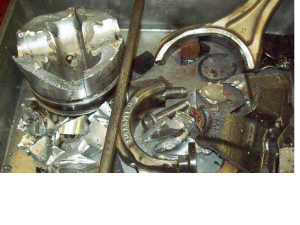I suspect our Christmas parties may have been a little unconventional.
We had the usual nibbles and drinks at the end of the day, combined with plenty of laughs about what had transpired through the year. But, I believe what made our workshop's Christmas parties very different was one of the activities that went on throughout the night. At the back of our shop would be a  line of cars in various states of poor condition. These were accumulated for about the last three months of the year. Mechanics and salespeople would keep their eyes out for old cars being traded in that were damaged and would be sent to the wrecker’s yard. Salesmen from the local yards would call and proffer suitable vehicles that could be included in the nights frivolities.
line of cars in various states of poor condition. These were accumulated for about the last three months of the year. Mechanics and salespeople would keep their eyes out for old cars being traded in that were damaged and would be sent to the wrecker’s yard. Salesmen from the local yards would call and proffer suitable vehicles that could be included in the nights frivolities.
We used to be quite discerning with these cars.
The criteria was as follows: Cheap, plentiful, and most importantly, running condition. (Not necessarily drivable) The collection would build up, sometimes to seven, eight, or more vehicles. As the night wore on we would take each car and place it in the centre of the parking area, and with the use of suitable positioned fixing points and strong tie-downs, the car was held in place. The staff would hover around it, discussing the pros and cons of each model, the mileage, the overall condition, type of car and history. We checked the oil and coolant level and anything else that might give a clue as to how to place our bets.
 You may well be wondering at this point what we were doing. Well, a time sheet would be passed around from person to person with a time matrix printed on it in increments of 30 seconds. Once the sheet was filled the car would be started and allowed to warm up for about a minute, then the throttle would be held wide open with a heavy object on the pedal. A timer would be started and we would wait for the inevitable sound of the engine disintegrating. It sounds cruel, I know - but we sure had some fun, and I learned a lot about engines put to extremes during that time. The winner was of course the person who was the most accurate in determining time of explosion or seize. What I found interesting was how some engines that we would think would last a few seconds actually lasted for significantly longer and vice versa. One common denominator though was how good the cooling system was and the age of the oil. That thin black oil or failing radiator was a sure sign to put just a few minutes on the betting-clock. Sometimes, engines would quit instantly while others would come to a slow stop. But the best fun was the loud noise of a big end knock with a sudden explosion!
You may well be wondering at this point what we were doing. Well, a time sheet would be passed around from person to person with a time matrix printed on it in increments of 30 seconds. Once the sheet was filled the car would be started and allowed to warm up for about a minute, then the throttle would be held wide open with a heavy object on the pedal. A timer would be started and we would wait for the inevitable sound of the engine disintegrating. It sounds cruel, I know - but we sure had some fun, and I learned a lot about engines put to extremes during that time. The winner was of course the person who was the most accurate in determining time of explosion or seize. What I found interesting was how some engines that we would think would last a few seconds actually lasted for significantly longer and vice versa. One common denominator though was how good the cooling system was and the age of the oil. That thin black oil or failing radiator was a sure sign to put just a few minutes on the betting-clock. Sometimes, engines would quit instantly while others would come to a slow stop. But the best fun was the loud noise of a big end knock with a sudden explosion!
About The Author: Alan Power
Alan Power, is a father, grandfather, husband, and a DIY enthusiast. He lives down-under in Western Australia and he enjoys spending time with his family and working in his home workshop. Not to mention enjoying maintaining and driving his classic cars.










